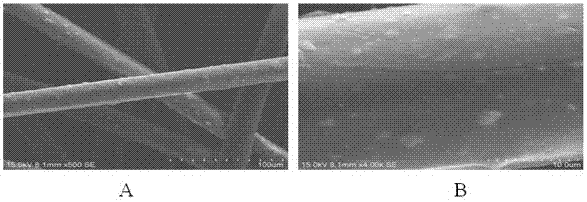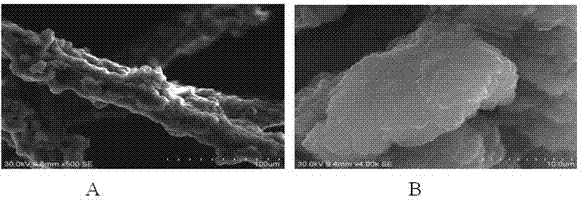Adsorption material for coupling tannin on the surface of non-woven fabric and its preparation method
A technology of adsorption materials and non-woven fabrics, applied in chemical instruments and methods, textiles and papermaking, and other chemical processes, can solve the adverse effects of color, taste and aroma, product loss, beer foaming and foam retention, etc. Problems, achieve the effect of overcoming manufacturing difficulty and poor strength and durability, low pressure loss of filtered water flow, and high filtration stability
- Summary
- Abstract
- Description
- Claims
- Application Information
AI Technical Summary
Problems solved by technology
Method used
Image
Examples
Embodiment 1
[0049] Example 1: The preparation method of the adsorption material coupled with tannin on the surface of the non-woven fabric is as follows:
[0050] (1) Preparation of acrylic grafted product of PP non-woven fabric
[0051] Refer to the method in the Chinese patent application (application number 201010559722.2) "A high carboxyl content ion exchange non-woven fabric and its preparation method", the specific operations are as follows:
[0052] A. Cut a batch of round PP non-woven fabrics with a diameter of 8cm (commercially available, specification: 10.5g / m 2 , Thickness 70.3μm, water absorption rate 36.1%), soak in acetone for 12h to remove surface oil and additives and other impurities, take it out and dry for use;
[0053] B. Mix acetone with 50% (volume percentage) and distilled water to form a mixed solvent, add acrylic acid, benzophenone and azobisisobutyronitrile to form a monomer solution for use. The concentration of each component is 50% acrylic acid (volume percentage) ),...
Embodiment 2
[0069] Example 2: The preparation method of the adsorption material coupled with tannin on the surface of the non-woven fabric is as follows:
[0070] (1) Preparation of acrylic grafted product of PP non-woven fabric
[0071] Refer to the method in the Chinese patent application (application number 201010559722.2) "A high carboxyl content ion exchange non-woven fabric and its preparation method". The specific operation is the same as the step (1) of Example 1. This example uses polypropylene (PP) For the non-woven fabric, the carboxyl group-containing unsaturated monomer is acrylic acid, and the carboxyl group content Sg of the acrylic acid grafted product of the obtained PP non-woven fabric is 6.1 mmol / g, and the water absorption rate is 802.1%.
[0072] (2) Preparation of PP non-woven fabric triethylenetetramine amination product
[0073] The PP non-woven acrylic grafted product is put into a catalyst composed of TETA and AlCl 3 .6H 2 Condensate in a solution prepared by O at 150°C...
Embodiment 3
[0081] Example 3: The preparation method of the adsorption material coupled with tannin on the surface of the non-woven fabric is as follows:
[0082] (1) Preparation of acrylic grafted product of PP non-woven fabric
[0083] Refer to the method in Chinese patent application (application number 201010559722.2) "A high carboxyl content ion exchange non-woven fabric and its preparation method". The specific operation is the same as the step (1) of Example 1. This example uses polypropylene non-woven fabric , See the FTIR spectrum figure 1 Middle line 1, see SEM photo figure 2 , See the thermal analysis TG-DTG curve Figure 7 A; The carboxyl-containing unsaturated monomer used is acrylic acid, the carboxyl content Sg of the acrylic acid grafted PP non-woven fabric is 7.0mmol / g, and its water absorption is 850.3%. The FTIR spectrum is shown in figure 1 Middle line 2, the characteristic absorption is in agreement with the literature value, see the SEM picture image 3 , See the therm...
PUM
| Property | Measurement | Unit |
|---|---|---|
| adsorption capacity | aaaaa | aaaaa |
| diameter | aaaaa | aaaaa |
| thickness | aaaaa | aaaaa |
Abstract
Description
Claims
Application Information
 Login to View More
Login to View More - R&D
- Intellectual Property
- Life Sciences
- Materials
- Tech Scout
- Unparalleled Data Quality
- Higher Quality Content
- 60% Fewer Hallucinations
Browse by: Latest US Patents, China's latest patents, Technical Efficacy Thesaurus, Application Domain, Technology Topic, Popular Technical Reports.
© 2025 PatSnap. All rights reserved.Legal|Privacy policy|Modern Slavery Act Transparency Statement|Sitemap|About US| Contact US: help@patsnap.com



